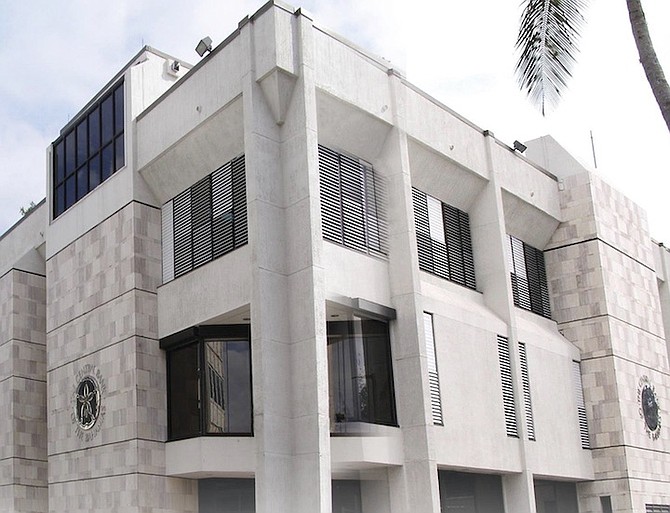By NEIL HARTNELL
Tribune Business Editor
nhartnell@tribunemedia.net
The Bahamas’ national debt shrank by almost $77m during the 2023 third quarter but this proved insufficient to reverse the total $400m-plus growth incurred over the prior 12 months, it was revealed yesterday.
The Central Bank, unveiling its quarterly review for the three months to end-September 2023, disclosed that the Government had managed to contain - and partially reverse - the continued build-up in the national debt that now exceeds more than $11.5bn.
“The direct charge on government fell by $45.6m (0.4 percent) over the June quarter, but rose by $437.8m (4.1 percent), on an annual basis to $11.215bn. The end-September disaggregation by currency revealed that Bahamian dollar debt represented 54.1 percent of the total, while foreign currency liabilities accounted for the remaining 45.9 percent,” the regulator said
“The Government’s contingent liabilities declined by $31.3m (8 percent) over the September quarter, and by $33.6m (8.6 percent) year-on-year to $358.4m. As a result, the national debt inclusive of contingent liabilities contracted by $76.8m (0.7 percent) over the three-month period but rose by $404.2m (3.6 percent) on an annual basis to $11.573bn as at end-September 2023.”
The Central Bank report affirmed that the decline in The Bahamas’ debt-to-gross domestic product (GDP) ratio, which measures the size of the country’s debts relative to that of the economy and its output, had resulted from post-COVID reflation rather than any cut to the debt itself.
“With the recovery in the GDP estimates, the ratio of the direct charge to GDP decreased by an estimated 5.5 percentage points on a yearly basis to 80.4 percent at September-end. In addition, the national debt-to-GDP declined to an estimated 80.1 percent compared to 89.1 percent in the third quarter of 2022,” the Central Bank added.
“The public sector foreign currency debt reduced by $182.6m (3.2 percent) to $5.598bn during the September quarter but grew by $28.4m (0.5 percent) relative to the same period last year. Specifically, amortisation payments amounted to $170.8m, while new drawings were negligible.
“A breakdown by components showed that the Government’s outstanding liabilities, at 92 percent of the total, fell by $171.8m (3.2 percent) to $5.152bn on a quarterly basis. The public corporations’ debt stock also decreased by $10.8m (2.4 percent) to $446.5m vis-à-vis the prior quarter,” the regulator continued.
“Relative to the same quarter of 2022, total foreign currency debt service payments were higher by $127.5m (131.6 percent) at $224.4m. In particular, government’s debt service payments expanded by $126.7m (158.8 percent) to $206.5m as amortisation payments rose to $160m from $43.1m same period last year, while interest charges increased by $9.8m (26.6 percent) to $46.5m.
“Likewise, the public corporations’ debt service payments firmed by $0.8m (4.5 percent) to $17.9m primarily due to a rise in amortisation payments by $2m (22.9 percent) to $10.8m while interest charges declined by $1.2m (14.8 percent) to $7.1m. As a consequence of these developments, the debt service ratio firmed to 16.3 percent at end-September from 7.2 percent in 2022.”
In the real economy, the Central Bank said mortgage-financed construction activity in the domestic sector remained relatively flat as growth continued to be driven by foreign direct investment (FDI) financed projects.
“Bank-financed domestic private sector activity remained subdued,” the Central Bank said. “In domestic financing developments, total mortgage disbursements for new construction and repairs, as reported by banks, insurance companies and the Bahamas Mortgage Corporation, rose by 3.3 percent ($0.7m) to $22m - a turnaround from the 2.1 percent decline a year earlier.
“Contributing to this development, residential disbursements expanded by 6.3 percent ($1.2m) to $20.7m, a switch from an 8.4 percent contraction in the prior year. Conversely, commercial disbursements reduced by 29 percent ($0.5m) to $1.3m, a reversal from the three-fold increase in 2022.
“Total mortgage commitments for new buildings and repairs - a forward-looking indicator of domestic activity - grew by six to 53 relative to the same period in 2022, while the associated value rose by 13.5 percent to $18.7m,” the Central Bank added.
“Categorized by loan type, the number of undisbursed residential commitments firmed by four to 50. However, the associated value declined by $2.8m (17 percent) to $13.6m. Further, commercial commitments for new construction and repairs increased by two to three, with the accompanying value higher at $5.1m vis-à-vis a muted $0.1m in the same period in the preceding year.
“In terms of interest rates, the average financing costs for residential mortgages narrowed by 39 basis points to 5.94 percent.”





Comments
Use the comment form below to begin a discussion about this content.
Sign in to comment
OpenID